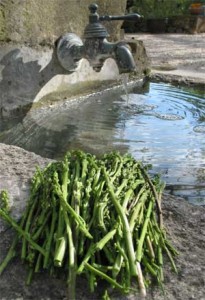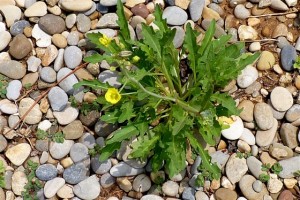I posted some photos/comments on FB this weekend of my hiking/camping trip with my grade 9’s. One of the things I have fun doing in the region is sharing with the kids the many wild plants that are edible. The comments on FB set off some great ideas for a MG novel and it reminded me how important it is to be using all the senses in our writing. Hiking and camping in the mountains is a sensation-bombardment, if you are: observing, listening, smelling, tasting, touching……… the fragrances of lavender, thyme and rosemary almost make the nostrils tingle with their intensity, along the hiking trails above Nice. There are also many wild fruit trees in our region, and depending on the season, I have introduced students to wild: cherries, figs, strawberries, raspberries, blueberries etc Late autumn hikes among the oak trees give way to foraging for the much prized Cèpes mushrooms.
Here are just a few of the local plants I have enjoyed gathering, cooking and eating:
Now, tell me what wild goodness could I expect to eat in your region? And, if you feel like it, a line or two from one of your WIP’s that have a sensorial component. Happy gathering!










Love hearing about your adventures into the rocky hills high above Nice. I can sooo imagine it.
We are often wary of mushrooms as there are many types growing wild here and some can be poisonous. Apart from mushrooms, we have quavas, figs, macadamia nut trees, blackberries, strawberries, and even certain types of herbs such as parsley and mint and watercress, and of course if your are lucky enough truffles.
Ooo yes, watercress I have eaten from streams up in the mountains, too! Macadamia nuts, yummee! I was fascinated to read you had truffles too, there Diane! When I go mushroom picking we take books with us and if in doubt, you can stop at a local chemist/pharmacy and ask them to check if it is poisonous or not. There are actually only three or four types I regularly pick!
Lucky, lucky you. Your hikes sound amazing. The wild asparagus looks yummy. Here in Florida I have a peach, avocado, and loquat tree.
We get wild asparagus that grows in the canal banks. I’ve never actually picked or eaten any, but I hear it’s completely pickable and eatable!
Cortney, my favorite spot to pick wild asparagus is also our local canal, even though it grows in loads of places. DO try it! It is finer and I think far tastier than cultivated asparagus. I sauté it olive oil and then toss it into an omelet or with tagliatelle!
Krista, I had to look up loquat, but then realized I do know them, it’s just I only knew the French word (nèfle)! hahaha 🙂 and I like them a lot.
Thanks Joanna. Our friends will not share their spot for finding wild asparagus, but they do share their dishes! Don’t know if you’ve ever read the guides from Euell Gibbons: Stalking the Wild Asparagus, and Stalking the Blue-Eyed Scallop (have them both!)
Oo, I haven’t read these, Julie, thanks so much for the recommendations. I recommend spying on your friends. 😉
Very “sensational” post!. Loved following you FB pictures and now your wonderful post of nature. Sounds like you gained a very important reminder that will no doubt influence your writing. We have wild raspberries and blackberries, many kinds of mushrooms, mint and things I’m not thinking of. My brother is the naturalist who lives off the wild. Enjoyed this — you are bouncing off the page. Great opportunity to connect with yourself — even though surrounded by students. Loved the journey.
Yes, Pat, sometimes we have to get out of our daily habitual sights, sounds and tastes etc to be reminded of all we take in during a 24 hour period. I love the mountains and sharing this passion with others.
I wish I was more educated on what is edible and what isn’t. Behind my grandma’s house was a wild blackberry patch. I loved to gorge myself in the berries whenever I visited her. Great advice in upping the sensory ante in our writing. BTW – You should check out a Toy Story movie. They’re charming.
I will follow up your Toy Story tip! We had a wild gooseberry bush at the back of our garden growing up. Loved this sour fruit!
When we lived in Spain, I had only 3 boys then; T was 5 and the twins were only 2. We lived in the foothills of the Pyrenees for a few months, and I have wonderful memories of the walks we took with the little guys, finding thyme and rosemary and letting them taste it, and watching my husband teach the boys to climb the big rocks. We never found any asparagus, though! Even now, whenever we go on hikes, they are always asking what there is to eat. I still make them check with me first, but we snack on chamomile, onion grass, mint, clover, blackberries, and whatever else is there. We also pick rose hips and bring them home to make tea; those aren’t nice eaten raw!
What fabulous memories for you and the boys! I make rose hips into a syrup! I confess I was surprised to see the aspargus where we were, as I wasn’t looking for it and I always gather it in a couple of parks or the canal around Nice! I love the Pyrenees as much as the Alps -quite different. Thanks for your comments. 🙂
I’ve become interested in herbs and edible wild foods and have tried to learn all I can in the past decade or so. It definitely enriches our lives.
P.S. Do try the fresh nettle tincture for your allergies someday. Its efficacy may surprise you! You also get a good dose of minerals, especially iron and calcium, and nettles are also very healing for the adrenals (something I’m dealing with right now).
It’s something I have invested time into, too, Laura.
I shall try out tincture of fresh nettle. I have recently tried essential oil of fennel as it hugely helped a friend with allergies, but it didn’t work for me. Wishing healing to h-those adrenals!
I have no idea of what to look for when I go hiking. Maybe I’ll start studying in my spare time. Thanks for the inspiration Joanna. Love the pictures btw
It adds a whole other dimension to the hike, like spotting all the animals tracks 🙂
Great post! It sounds like you had a super time. I love picking the fruits of the earth, so to speak. Wild berries, wild onions and mint, being my favorite. Hiking is something our family does all summer. And we ride our horses too. It’s a fun way to stay healthy. Thank you for sharing your wonderful weekend with us.
Robyn, it’s been far too long since I rode horses. It is another superb way to experience the countryside!
Now’s the time for fiddleheads in our neck of the woods. And, it’s not “wild,” but fresh asparagus from my parents’ farm can’t be beat!
I confess I have never eaten fiddleheads, Michelle. I really must. Asparagus is one of my absolute favorite vegetables!
Mmmm. Your wild edibles look delicious. Last night I made a few drinks with some wild mint from my backyard. Blackberries also grow like crazy here in Oregon, but they are non-native and actually quite a nusiance.
I often make tea from my mint, and then jam or crumble from blackberries, but they are so sweet, I think they are best married with a sour fruit!
I must send the link to this post to my cousin Joyce, who will be able to tell you what she finds along the banks of the Thames in London, Ontario. (That Ontario part surprised you, I’ll bet…) Her sister, Bev, (yes, the author one) made flour from cattail roots and made cookies for her grade two class once long ago.
I’m most familiar with the wild berries that are available here in Saskatchewan. Wild strawberries (if you know where to find them — it was Joyce and Bev’s parents who took me on a hike to find those). We used to pick wild saskatoon berries when I was a kid. They are wonderful, but hard to describe. Chokecherries are also favored by some (though not me).
The people who could really tell you about wild food here are the First Nations elders.
Hahah, you had me, until I read on to Ontario! After Wild Orchid, I would kind of expect Bev, to know some great edible plants too!
I have no clue Joanna. I fear I might starve if lost in the woods. The wild salad greens look similar to some plants here.
Actually, Stacy, quite a lot of wild plants can be tossed into salad greens.
Beautiful photographs and wonderful that the trip sparked ideas for an MG novel! As for what grows in my neck of the woods, well, you know I live on Blueberry Hill 🙂
There are lots of edible wild salad greens growing along the Thames in Ontario; I don’t feel comfortable eating them though because we do so much spraying for mosquitoes here. We can now get dandelion leaves in grocery stores and they’re a slightly bitter wonderful addition to salads. The leaf looks like the picture of Wild Roquettes but the flower though bright yellow is composed of dozens of florets. My mother went to a rural school in Saskatchewan and told us about some kids who used to go into the schoolyard at noonhour, pick dandelion leaves, slap them on a piece of bread, and eat that for their lunch. We also used to go out picking wild chokecherries. They have quite a strong flavour but make really delicious syrup. A few years ago I picked a few quarts when I was home for a visit and did some experimenting making chokecherry jam. It’s quite labour intensive (each berry has a pit that has to be cut out) but the results were definitely worth it. (Beth: If I ever do that again I’ll send you a jar…)
Joyce, loved hearing from your neck of the woods. I, like you, am very careful about where I gather because of pollution, pesticides etc. We have only just started spraying against mosquitoes in Nice two years ago, since the tiger mosquitoes invaded!
I LOVE your anecdote of dandelion leaf sandwiches in the Saskatchewan playground – 🙂 Have just goggle chokecherries. YUM! damson and cherry are two of my favorite jams, but a lot of hard work removing those pits!
Thanks so much for visiting the blog!